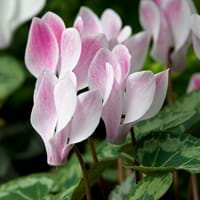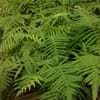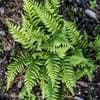Life Span
Perennial
Perennial
Type
Fern
Flowering Plants, Tubers
Origin
Southeastern Asia
Europe, Mediterranean Basin, Middle East, North Africa, Somalia
Types
Bigleaf hydrangea, Hortensia, Smooth hydrangea, Oakleaf hydrangea, Annabelle
Cyclamen Africanum, Cyclamen Alpinum, Cyclamen Cilicium, Cyclamen Coum
Habitat
Forest edges, Hillside, Woods
Alpine Meadows, Rocky areas, Woods
USDA Hardiness Zone
9-11
5-9
Sunset Zone
H1, H2, 17, 23, 24
15, 16, 17, 18, 19, 20, 21, 22, 23, 24
Habit
Spreading
Clump-Forming
Flower Color
Blue, Dark Purple, Light Purple, Red, White
Pink, Purple, White
Flower Color Modifier
Bicolor
Not Available
Fruit Color
Not Available
Brown
Leaf Color in Spring
Green, Light Green
Several shades of Green
Leaf Color in Summer
Green, Light Green
Not Available
Leaf Color in Fall
Green, Light Green
Green, Silver
Leaf Color in Winter
Light Green
Green, Silver
Leaf Shape
Oblovate
Heart-shaped
Plant Season
Spring, Summer, Fall, Winter
Autumn, Spring, Summer, Winter
Sunlight
Partial shade, Full Shade
Indirect sunlight
Type of Soil
Loam
Clay, Sandy, Well drained
The pH of Soil
Acidic
Acidic
Soil Drainage
Well drained
Well drained
Bloom Time
Spring, Summer
Autumn, Spring, Summer
Tolerances
Drought
Not Available
Where to Plant?
Container, Ground
Container, Ground, Pot
How to Plant?
Seedlings, Stem Planting
From bulbs, Seedlings
Plant Maintenance
Medium
Medium
Watering Requirements
Not Available
Do not water frequently, It cannot sustain wet-feet, Keep the ground moist but not water-logged, Prefer drip-irrigation instead of Over-head watering, Water when soil is dry
In Summer
Average Water
Lots of watering
In Spring
Moderate
Moderate
In Winter
Average Water
Average Water
Soil Type
Loam
Clay, Sandy, Well drained
Soil Drainage Capacity
Well drained
Well drained
Sun Exposure
Partial shade, Full Shade
Indirect sunlight
Pruning
Remove damaged leaves, Remove dead branches, Remove dead leaves
Cut or pinch the stems, Prune if you want to improve plant shape, Prune ocassionally, Prune to control growth, Prune when plant is dormant, Remove dead leaves, Remove dead or diseased plant parts
Fertilizers
All-Purpose Liquid Fertilizer
All-Purpose Liquid Fertilizer
Pests and Diseases
Red blotch
Aphids, Botrytis Cinerea, Gray mold, Mice, Mites, Root weevil, Slugs, Snails, Squirrels
Plant Tolerance
Drought
Drought
Flower Petal Number
Single
Single
Foliage Texture
Fine
Medium
Foliage Sheen
Glossy
Matte
Attracts
Bees, Flies
Not Available
Allergy
Chest tightness, Diarrhea, Dizziness, Nausea, Vomiting
Respiratory problems
Aesthetic Uses
Not Available
Showy Purposes
Beauty Benefits
Not Available
Not Available
Edible Uses
Not Available
Unknown
Environmental Uses
Air purification
Air purification
Medicinal Uses
Fever, Kidney problems, Urinary tract problems
Digestive disorders, Menstrual Disorders
Part of Plant Used
Flowers, Root
Root, Stem
Other Uses
Not Available
Showy Purposes, Used as an ointment
Used As Indoor Plant
Not Available
Yes
Used As Outdoor Plant
Yes
Yes
Garden Design
Container, Groundcover, Hanging Basket, Houseplant, Tropical
Not Available
Botanical Name
DAVALLIA trichomanoides
Cyclamen Persicum
Common Name
Squirrel's Foot Fern
Cyclamen or Florist's Cyclamen
In Hindi
Hydrangea
Sikalemen
In German
Hortensie
Zyklamen
In French
Hortensia
Cyclamen
In Spanish
Hortensia
Ciclamen
In Greek
υδραγεία
κυκλάμινο
In Portuguese
Hortênsia
Cíclame
In Polish
Hortensja
Cyklamen
In Latin
Hibiscus
Cyclamīnos
Phylum
Not Available
Anthophyta
Class
Not Available
Dicotyledonae
Order
Not Available
Ericales
Family
Davalliaceae
Primulaceae
Genus
Not Available
Cyclamen
Clade
Not Available
Not Available
Tribe
Not Available
Cyclamineae
Subfamily
Not Available
Myrsinoideae
Number of Species
Not Available
Properties of Squirrel's Foot Fern and Cyclamen
Wondering what are the properties of Squirrel's Foot Fern and Cyclamen? We provide you with everything About Squirrel's Foot Fern and Cyclamen. Squirrel's Foot Fern doesn't have thorns and Cyclamen doesn't have thorns. Also Squirrel's Foot Fern does not have fragrant flowers. Squirrel's Foot Fern has allergic reactions like Chest tightness, Diarrhea, Dizziness, Nausea and Vomiting and Cyclamen has allergic reactions like Chest tightness, Diarrhea, Dizziness, Nausea and Vomiting. Compare all the properties and characteristics of these two plants. Find out which of these plant can be used as indoor plant. If you are interested to decorate your house and garden, find out aesthetic uses, compare them and select the plant which will beautify your surrounding. Along with beautification, try comparing medicinal and edible uses of Squirrel's Foot Fern and Cyclamen and you can choose the plant having best and most benefits.
Season and Care of Squirrel's Foot Fern and Cyclamen
Season and care of Squirrel's Foot Fern and Cyclamen is important to know. While considering everything about Squirrel's Foot Fern and Cyclamen Care, growing season is an essential factor. Squirrel's Foot Fern season is Spring, Summer, Fall and Winter and Cyclamen season is Spring, Summer, Fall and Winter. The type of soil for Squirrel's Foot Fern is Loam and for Cyclamen is Clay, Sandy, Well drained while the PH of soil for Squirrel's Foot Fern is Acidic and for Cyclamen is Acidic.
Squirrel's Foot Fern and Cyclamen Physical Information
Squirrel's Foot Fern and Cyclamen physical information is very important for comparison. Squirrel's Foot Fern height is 6.56 cm and width 10.50 cm whereas Cyclamen height is 0.54 cm and width 0.75 cm. The color specification of Squirrel's Foot Fern and Cyclamen are as follows:
Squirrel's Foot Fern flower color: Blue, Dark Purple, Light Purple, Red and White
Squirrel's Foot Fern leaf color: Green and Light Green
Cyclamen flower color: Pink, Purple and White
- Cyclamen leaf color: Several shades of Green
Care of Squirrel's Foot Fern and Cyclamen
Care of Squirrel's Foot Fern and Cyclamen include pruning, fertilizers, watering etc. Squirrel's Foot Fern pruning is done Remove damaged leaves, Remove dead branches and Remove dead leaves and Cyclamen pruning is done Cut or pinch the stems, Prune if you want to improve plant shape, Prune ocassionally, Prune to control growth, Prune when plant is dormant, Remove dead leaves and Remove dead or diseased plant parts. In summer Squirrel's Foot Fern needs Average Water and in winter, it needs Average Water. Whereas, in summer Cyclamen needs Lots of watering and in winter, it needs Average Water.



